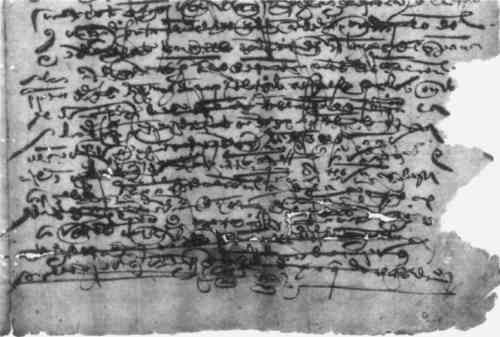THE EXAMINATION AND CONSERVATION TREATMENT OF THE LIBRARY OF CONGRESS HARKNESS 1531 HUEJOTZINGO CODEXSYLVIA RODGERS ALBRO, & THOMAS C. ALBRO
2 CONDITION PRIOR TO TREATMENTTHE HUEJOTZINGO CODEX was brought to the attention of the Library of Congress's Conservation Office for examination in 1986 by the Manuscript Division because the manuscript was in poor condition and thus unavailable to scholars for study. It consisted of three parts: 1) 74 foliated leaves of Spanish text written in brown ink on antique laid paper—side-stitched together; 2) five loose leaves of the same text that had been silked; and 3) eight fold-out Indian drawings in color on native-made papers sewn into the center of the manuscript. The manuscript was housed in a box that was too large, so that the parts shifted around easily. Handling had already soiled, curled, and torn many of the leaves, and any additional handling risked further damage. Some of the writing inks used throughout the Spanish text were very acidic and had eaten through the paper extensively (fig. 6). A pile of broken fragments had collected in the bottom of the storage box. The tight sewing structure was actively damaging both the European and Mexican papers and prevented the manuscript from opening easily and lying flat. As a result, a microfilm of the manuscript made in 1942 did not show the writing closest to the spine. A number of the text pages had torn loose from the binding.
The Indian papers were delicate, and repeated unfolding and folding to fit into the manuscript format had caused wearing and fraying along the fold lines. Pigments from the drawings were crumbling and brittle along the fold lines as well. The silked leaves had a flat character completely different from that of the text. The writing was obscured and difficult to read. In addition, leaves had been joined and silked in a form that did not follow the correct collation order. The rarity and exceptional quality of the manuscript made it an excellent candidate for detailed study. A close examination undertaken by the Conservation Office with the cooperation of the Library's Manuscript and Hispanic divisions produced a proposal for the conservation treatment of the codex and simultaneously disclosed a wealth of information about the materials and practices used by both Spanish and Indian cultures in the early colonial period in Mexico. 2.1 COLLATION AND SEWINGTHE MANUSCRIPT was sewn in legajo form (sections side-stitched along the spine edge) with at least six different kinds of sewing threads.4 These included red, green, and buff-colored loose twist threads that intersected repeatedly throughout the text. It is likely that the manuscript had been reorganized on occasion, as several of the threads were loose fragments with no sewing purpose and a number of leaves distributed throughout the text had additional sets of sewing holes, indicating a previous sewing. As the lengthy lawsuit proceeded, accumulated material was probably added to the manuscript periodically. The number of leaves in each section varied from one leaf to seven foliated leaves. The sections were sewn into bundles, which pulled and rubbed against each other unevenly when the manuscript was handled. The Indian drawing papers were sewn into the manuscript with a dark green thread not found elsewhere in the sewing structure. Tension at the sewing points had caused tearing of the drawing papers. |
